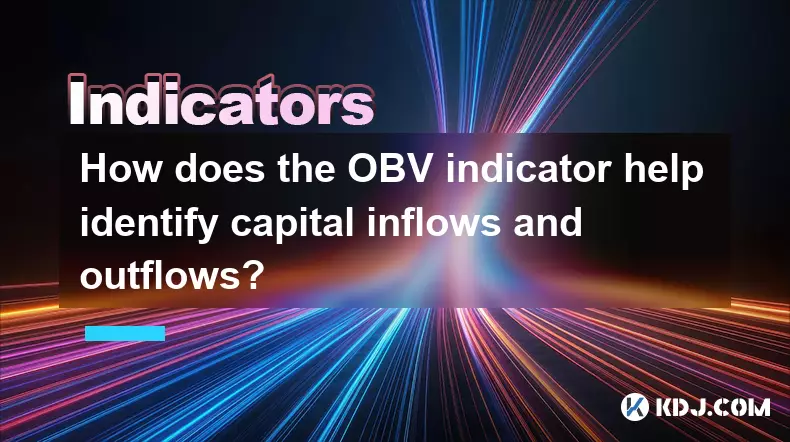-
 bitcoin
bitcoin $87959.907984 USD
1.34% -
 ethereum
ethereum $2920.497338 USD
3.04% -
 tether
tether $0.999775 USD
0.00% -
 xrp
xrp $2.237324 USD
8.12% -
 bnb
bnb $860.243768 USD
0.90% -
 solana
solana $138.089498 USD
5.43% -
 usd-coin
usd-coin $0.999807 USD
0.01% -
 tron
tron $0.272801 USD
-1.53% -
 dogecoin
dogecoin $0.150904 USD
2.96% -
 cardano
cardano $0.421635 USD
1.97% -
 hyperliquid
hyperliquid $32.152445 USD
2.23% -
 bitcoin-cash
bitcoin-cash $533.301069 USD
-1.94% -
 chainlink
chainlink $12.953417 USD
2.68% -
 unus-sed-leo
unus-sed-leo $9.535951 USD
0.73% -
 zcash
zcash $521.483386 USD
-2.87%
How does the OBV indicator help identify capital inflows and outflows?
The On-Balance Volume (OBV) indicator tracks cumulative volume flow, helping traders spot capital inflows or outflows by linking volume to price changes.
Sep 13, 2025 at 08:54 am

Understanding the On-Balance Volume (OBV) Indicator
1. The On-Balance Volume (OBV) indicator is a technical analysis tool used to track the flow of volume in relation to price changes. It operates on a cumulative basis, adding volume on days when the price closes higher and subtracting volume on days when the price closes lower. This mechanism allows traders to observe whether volume is flowing into or out of an asset.
2. OBV provides a running total of volume pressure, making it easier to spot accumulation and distribution phases in the market. When the price and OBV rise together, it signals strong buying interest, indicating capital inflow. Conversely, if the price rises but OBV falls, it may suggest a lack of volume support, hinting at potential weakness or hidden selling pressure.
3. The simplicity of OBV lies in its calculation: if today’s closing price is higher than yesterday’s, today’s volume is added to the previous OBV value. If the closing price is lower, today’s volume is subtracted. If the close is unchanged, OBV remains the same. This creates a continuous line that reflects the balance between buying and selling volume over time.
4. In the context of cryptocurrency trading, where volatility and speculative movements are common, OBV helps filter out noise by focusing on volume-backed price moves. Assets experiencing sharp price increases without corresponding OBV growth may be prone to reversals, as the rally lacks volume confirmation.
5. Traders often use OBV in conjunction with price trends to validate breakouts or warn of potential reversals. A breakout accompanied by a rising OBV strengthens the signal, while a breakout with flat or declining OBV may be viewed with skepticism.
Identifying Capital Inflows Using OBV
1. A sustained increase in OBV while the asset’s price climbs indicates consistent buying pressure and capital inflow. This alignment suggests that investors are actively purchasing the asset, supporting further upward momentum. In the crypto market, this often occurs during bullish sentiment cycles or major project developments.
2. When OBV reaches new highs along with price, it confirms the strength of the uptrend. For instance, if Bitcoin’s price moves above a previous peak and OBV simultaneously exceeds its prior high, it signals fresh demand and participation from new capital.
3. Divergences can also be analyzed in reverse: if the price is consolidating but OBV is steadily rising, it may indicate quiet accumulation by informed investors before a potential breakout. This stealthy inflow is especially relevant in low-liquidity altcoins where large players can accumulate without moving the price drastically.
4. In trending markets, OBV can act as a leading indicator. A sharp spike in OBV preceding a price move often reflects early institutional or whale activity, giving retail traders a signal to monitor for upcoming momentum.
5. Monitoring OBV across different timeframes—such as daily, 4-hour, or weekly—allows traders to assess the durability of capital inflows. A rising OBV on higher timeframes suggests long-term accumulation, while short-term spikes may reflect speculative surges.
Recognizing Capital Outflows Through OBV
1. A declining OBV trend despite stable or rising prices signals distribution and potential capital outflow. This scenario often occurs when large holders sell into strength, causing volume to be subtracted from OBV even as retail buying pushes the price up temporarily.
2. If the price of an altcoin reaches a new high but OBV fails to surpass its previous peak, it forms a bearish divergence. This warns that the rally lacks broad participation and may collapse once selling pressure overwhelms weak buying.
3. Sudden drops in OBV following a price increase can indicate panic selling or coordinated exits by major stakeholders. In decentralized finance (DeFi) tokens, such drops may follow exploit rumors or governance vote outcomes, prompting rapid capital flight.
4. Extended periods of flat or declining OBV in a sideways market suggest apathy or gradual selling. Even if the price holds steady, diminishing volume behind the scenes reflects weakening support and potential downside risk.
5. In highly leveraged markets like crypto futures, a falling OBV during a price correction can amplify liquidations, as reduced buying volume fails to absorb selling pressure, accelerating downward moves.
Common Questions About OBV in Crypto Trading
What does a flat OBV line indicate in a cryptocurrency chart?A flat OBV line suggests that volume is not significantly favoring either buying or selling. In a ranging market, this reflects equilibrium. However, if the price is rising while OBV remains flat, it may indicate a lack of conviction behind the move.
Can OBV be used effectively for low-cap altcoins?Yes, but with caution. Low-cap coins often experience erratic volume spikes due to pump-and-dump schemes. OBV can help identify genuine accumulation if the volume increase is sustained and aligned with price, rather than short-lived spikes.
How does OBV differ from traditional volume bars?While volume bars show total traded volume per period, OBV assigns directionality—adding volume on up days and subtracting on down days. This creates a cumulative flow metric that reveals underlying buying or selling dominance over time.
Is OBV reliable during major news events in the crypto space?OBV can be volatile during news-driven events due to sudden volume surges. However, observing how OBV behaves after the initial spike—whether it sustains upward momentum or collapses—can reveal whether the reaction is supported by lasting capital flow or just short-term speculation.
Disclaimer:info@kdj.com
The information provided is not trading advice. kdj.com does not assume any responsibility for any investments made based on the information provided in this article. Cryptocurrencies are highly volatile and it is highly recommended that you invest with caution after thorough research!
If you believe that the content used on this website infringes your copyright, please contact us immediately (info@kdj.com) and we will delete it promptly.
- XRP, Ethereum, Crypto Buy: Navigating the Shifting Sands of Crypto Investments
- 2025-11-26 11:15:01
- Crypto, FLOKI, Apeing: Navigating the Meme Coin Frenzy Like a Wall Street Wolf
- 2025-11-26 10:45:02
- XRP, Ethereum, Crypto Buy: Decoding the Digital Asset Landscape
- 2025-11-26 11:35:01
- Aptos' Price Performance Struggles: Is There Hope for a Rebound?
- 2025-11-26 09:15:01
- Chainlink (LINK) Open Interest: Bulls Eye $15 Amid ETF Buzz!
- 2025-11-26 10:15:01
- PEPE, ZCash, and Zero Knowledge: A Tale of Three Cryptos
- 2025-11-26 06:45:01
Related knowledge

What is Relative Volume (RVOL) and why is it crucial for identifying crypto breakouts?
Nov 24,2025 at 11:20am
Understanding Relative Volume (RVOL) in the Crypto Market1. Relative Volume (RVOL) measures the current trading volume of a cryptocurrency against its...

What does a divergence on the RSI or MACD indicate for a crypto's future price?
Nov 24,2025 at 08:19am
Understanding Divergence in Technical Analysis1. Divergence occurs when the price of a cryptocurrency moves in the opposite direction of a technical i...

What are liquidation levels in crypto and how do they influence price action?
Nov 23,2025 at 05:00am
Liquidation Levels and Their Role in Crypto Markets 1. Liquidation levels refer to specific price points at which traders' leveraged positions are aut...

What is a Bullish Engulfing pattern and what does it signify in crypto trading?
Nov 24,2025 at 10:20pm
Understanding the Bullish Engulfing Pattern1. The Bullish Engulfing pattern is a two-candlestick formation commonly observed in cryptocurrency price c...

What is the difference between an SMA and an EMA in crypto technical analysis?
Nov 21,2025 at 11:39pm
Understanding SMA and EMA in Crypto TradingIn the world of cryptocurrency trading, technical analysis plays a crucial role in decision-making. Among t...

What is Order Book Depth and what can it tell you about supply and demand?
Nov 22,2025 at 11:20am
Understanding Order Book Depth1. Order book depth refers to the volume of buy and sell orders at various price levels within a trading pair on an exch...

What is Relative Volume (RVOL) and why is it crucial for identifying crypto breakouts?
Nov 24,2025 at 11:20am
Understanding Relative Volume (RVOL) in the Crypto Market1. Relative Volume (RVOL) measures the current trading volume of a cryptocurrency against its...

What does a divergence on the RSI or MACD indicate for a crypto's future price?
Nov 24,2025 at 08:19am
Understanding Divergence in Technical Analysis1. Divergence occurs when the price of a cryptocurrency moves in the opposite direction of a technical i...

What are liquidation levels in crypto and how do they influence price action?
Nov 23,2025 at 05:00am
Liquidation Levels and Their Role in Crypto Markets 1. Liquidation levels refer to specific price points at which traders' leveraged positions are aut...

What is a Bullish Engulfing pattern and what does it signify in crypto trading?
Nov 24,2025 at 10:20pm
Understanding the Bullish Engulfing Pattern1. The Bullish Engulfing pattern is a two-candlestick formation commonly observed in cryptocurrency price c...

What is the difference between an SMA and an EMA in crypto technical analysis?
Nov 21,2025 at 11:39pm
Understanding SMA and EMA in Crypto TradingIn the world of cryptocurrency trading, technical analysis plays a crucial role in decision-making. Among t...

What is Order Book Depth and what can it tell you about supply and demand?
Nov 22,2025 at 11:20am
Understanding Order Book Depth1. Order book depth refers to the volume of buy and sell orders at various price levels within a trading pair on an exch...
See all articles










































































